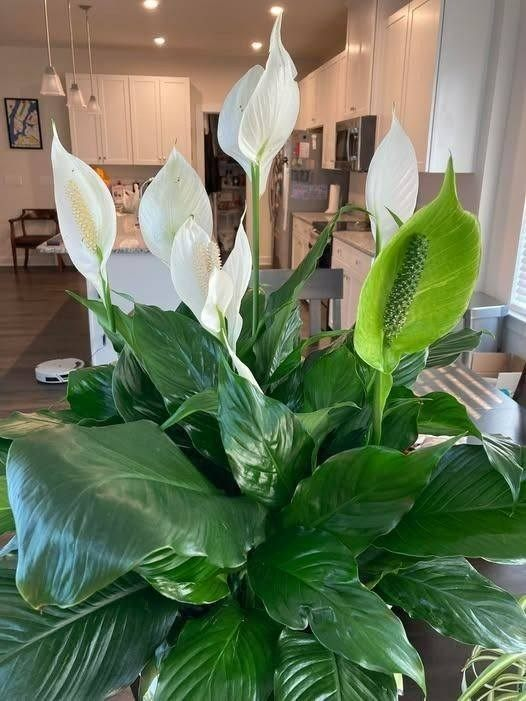There’s something deeply satisfying about seeing your peace lily (Spathiphyllum) bloom.
That elegant white spathe (the flower-like hood) emerging from deep green foliage feels like a silent thank-you from your plant:
“You’re doing great. I’m happy here.”
Peace lilies are beloved for their lush leaves, air-purifying power, and graceful blooms — but if yours rarely flowers, you’re not alone.
The good news?
👉 With a few simple care tweaks, you can encourage more frequent, longer-lasting blooms — year after year.
Let’s dive into the real reasons peace lilies bloom (or don’t) — and how you can create the perfect environment for lush, white flowers to appear.
🌸 Why Peace Lilies Stop Flowering
Peace lilies want to bloom — but they only do so when conditions are just right.
Common reasons for few or no flowers:
❌ Not enough light (most common cause)
❌ Overwatering or poor drainage
❌ Lack of nutrients
❌ Too much or too little humidity
❌ Being root-bound for too long
✅ The good news? All of these are fixable.
✅ 6 Proven Tips to Get Your Peace Lily to Flower More
1. Give It Bright, Indirect Light
see continuation on next page
Peace lilies thrive in medium to bright indirect light
Too little light = lush leaves, no flowers
Too much direct sun = scorched leaves
✅ Best spot: Near an east-facing window or a north-facing window with sheer curtains
✅ Sign of good light: Leaves are vibrant green, not dark or yellow
💡 Rotate the pot weekly for even growth.
2. Water Right – Not Too Much, Not Too Little
Peace lilies hate soggy soil but wilt dramatically when thirsty
Let the top 1–2 inches of soil dry out between waterings
Use a pot with drainage holes — never let it sit in water
✅ Pro tip: Water when the leaves droop slightly — then perk up after watering (a natural signal!).
3. Boost Humidity (They Love Moist Air)
Native to tropical rainforests, peace lilies love high humidity (50–60%)
Low humidity = brown leaf tips and fewer blooms
✅ Easy fixes:
see continuation on next page
Place on a pebble tray with water
Group with other plants
Use a small humidifier
Mist leaves occasionally (not a substitute for humidity)
4. Feed It (But Don’t Overdo It)
Peace lilies need light feeding to support flowers
Use a balanced liquid houseplant fertilizer (e.g., 10-10-10 or 20-20-20)
Feed every 6–8 weeks during spring and summer
Stop in fall and winter
✅ Tip: Dilute to half-strength — peace lilies are sensitive to salt buildup.
5. Keep It Warm (No Cold Drafts!)
Ideal temperature: 65–80°F (18–27°C)
Avoid cold windows, AC vents, or drafty doors
Cold stress = no flowering and leaf damage
✅ Keep away from drafty areas — especially in winter.
6. Repot When Root-Bound (But Not Too Soon)
see continuation on next page
Peace lilies bloom best when slightly root-bound
But if roots are growing out the bottom or the soil dries too fast, it’s time to upgrade
✅ When to repot: Every 2–3 years, in spring
✅ Use well-draining potting mix (with perlite or orchid bark)
🌱 Bonus: How to Care for Your Peace Lily Between Blooms
Wipe leaves with a damp cloth
Removes dust and improves photosynthesis
Remove spent flowers
Cut at the base to redirect energy
Trim brown tips
Use clean scissors — don’t pull
Rotate the plant
Promotes even growth and light exposure
🌼 What to Expect: Flowering Patterns
Peace lilies typically bloom in spring and summer
Each bloom lasts 4–6 weeks
With ideal care, some varieties bloom 2–3 times per year
The “flower” is actually a modified leaf (spathe) surrounding a spadix (the real flower part)
✅ Blooms start green, turn white, then age back to green or greenish-yellow.
see continuation on next page
Final Thoughts
Getting your peace lily to flower isn’t about magic — it’s about meeting its basic needs with a little extra attention.
You don’t need a green thumb.
Just:
The right light
The right water
A little humidity and food
And when that first white bloom appears?
You’ll know your plant feels safe, seen, and thriving.
Because peace lilies don’t just survive —
they bloom for those who listen.
